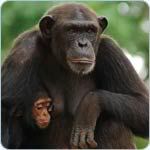Over 100 million animals are used every year in the United States as models in biological and medical research to study human disease, injury, development, psychology, and anatomy and physiology. Animals often suffer greatly in these studies, as they are inflicted with diseases, traumas, and pain they would not normally experience in order to mimic human conditions.
An entire industry has been built around supplying animals for research that treats animals as tools rather than as thinking, feeling beings. Animals are purposely bred for research or bought from auctions, pounds, shelters, ‘free to good home’ ads, or other random sources. Kept in sterile environments with little attention or enrichment, treated roughly for not ‘cooperating,’ and transported under unacceptable conditions, the pain and distress that animals used in research experience actually starts long before they enter a laboratory.
Non-human Primates

The numbers of nonhuman primates used in research has gradually increased in the last decade and significantly exceeds the numbers of nonhuman primates used when the USDA first began to record numbers of animals utilized in research. In 1973, the first year for which records were kept, 42,298 nonhuman primates were used, and in 2006, the latest year for which records are available, 62,315 were used. These figures do not take into account the nonhuman primates used for breeding. In addition, 47% of nonhuman primates, some 29,000 individuals, were subjected to painful and distressful experiments in 2006.
Primates are increasingly used in pharmaceutical and bioterrorism experiments, and researchers continue to promote the "development of a portfolio of non-human primate models for a variety of human diseases and conditions." For example, primates are used in experiments related to infectious disease (e.g., AIDS, malaria, TB, Lyme disease, Ebola), cardiovascular disease, diabetes, drug abuse, xenotransplanta......tion (cross-species transplants), toxicology, vaccinations, age-related research, gene therapy, neurosciences, and reproductive biology. Primates have rich emotional and social lives, however, and suffer greatly when confined in laboratory settings and used in scientific procedures.
Cynomolgus macaques (Macaca fascicularis), also known as crab-eating macaques, make up the majority of non-human primates imported for research. Rhesus macaques (Macaca mulatta) are the second most imported primate species. Other highly-......imported species include common marmosets, squirrel monkeys, olive baboons, vervet monkeys (also known as grivet or African green monkeys), and night monkeys (also known as owl monkeys). Wild populations of primates all across the world are being devastated to supply the research community.
The chimpanzee (Pan troglodytes) is the only nonhuman great ape species used in biomedical research. The majority of research involving chimpanzees is invasive, meaning that the projects involve infectious agents, drug testing, and/or surgery or biopsy. Because of their similarity to humans, chimpanzee research in particular raises serious ethical and scientific concerns, and there is growing public support in the U.S. for a ban on the use of chimpanzees in research.
There have been milestones along the way towards that goal. In May of 2007, after prodding from AAVS and other concerned organizations, the National Institutes of Health’s National Center for Research Resources announced that it would permanently end the breeding of government-......owned chimpanzees. In December of that same year, the Chimp Haven is Home Act was signed into law, closing a loophole in the 1999 Chimpanzee Health Improvement, Maintenance, and Protection (CHIMP) Act and assuring permanent retirement in sanctuaries for chimpanzees who have been removed from federal laboratories.
Great Britain, New Zealand, The Netherlands, and Japan have already restricted or prohibited great ape research.
Source and other animals used in research
No comments:
Post a Comment